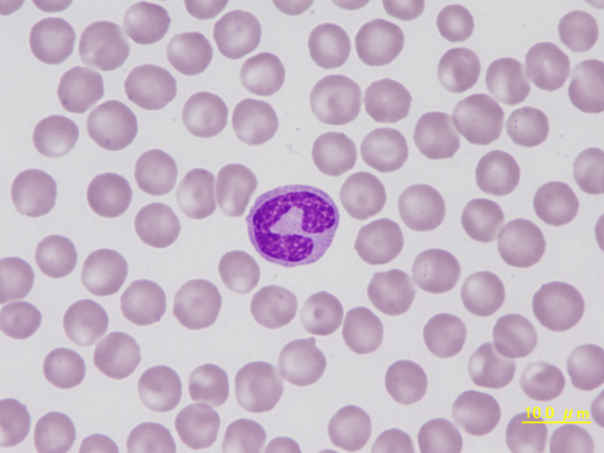Scientific Image Gallery
Welcome to our Scientific Image Gallery. Here you can find real-life examples of cell images, mostly (but not only) from peripheral blood films, that illustrate typical morphologic characteristics pointing to specific conditions or disorders. This constitutes their diagnostic value.
Click on an image to enlarge it and display a short description.

It is extremely rare that cancerous cells leak into the peripheral blood. Here, cells from a breast carcinoma are visible on the blood film.
<p>It is extremely rare that cancerous cells leak into the peripheral blood. Here, cells from a breast carcinoma are visible on the blood film.</p>

Cabot rings are round to oval or loop-like, fine, red-purple inclusions in red blood cells. They are remnants of the mitotic spindle apparatus. They can be seen with severe anaemia, e.g. thalassaemia, but are unspecific.
<p>Cabot rings are round to oval or loop-like, fine, red-purple inclusions in red blood cells. They are remnants of the mitotic spindle apparatus. They can be seen with severe anaemia, e.g. thalassaemia, but are unspecific. </p>

The yellow arrow points to a red blood cell infected with Babesia gibsoni, a protozoan transmitted by ticks. In the centre, there is a nucleated red blood cell. Overall, an increased number of polychromatic and differently sized red blood cells can be seen.
<p>The yellow arrow points to a red blood cell infected with Babesia gibsoni, a protozoan transmitted by ticks. In the centre, there is a nucleated red blood cell. Overall, an increased number of polychromatic and differently sized red blood cells can be seen. </p>

Aggregated large platelets, a segmented neutrophil (left) and a neutrophilic metamyelocyte (right). This sample was taken from a dog with chronic inflammation and acute haemorrhage a few days before.
<p>Aggregated large platelets, a segmented neutrophil (left) and a neutrophilic metamyelocyte (right). This sample was taken from a dog with chronic inflammation and acute haemorrhage a few days before. </p>

This atypical lymphocyte of a dog shows strong grey to blue cytoplasm and may be seen in blood smears from dogs responding to antigenic stimulation.
<p>This atypical lymphocyte of a dog shows strong grey to blue cytoplasm and may be seen in blood smears from dogs responding to antigenic stimulation. </p>

Atypical lymphocyte of a dog. The cell is large, with rough chromatin and dark blue cytoplasm. It is activated by various antigenic stimuli of the lymphatic tissue and changes morphologically.
<p>Atypical lymphocyte of a dog. The cell is large, with rough chromatin and dark blue cytoplasm. It is activated by various antigenic stimuli of the lymphatic tissue and changes morphologically.</p>

Band neutrophil with condensed chromatin and only mild constriction of the nucleus. The horseshoe shape of the nucleus is commonly seen with this young form of a neutrophilic granulocyte.
<p>Band neutrophil with condensed chromatin and only mild constriction of the nucleus. The horseshoe shape of the nucleus is commonly seen with this young form of a neutrophilic granulocyte.</p>

